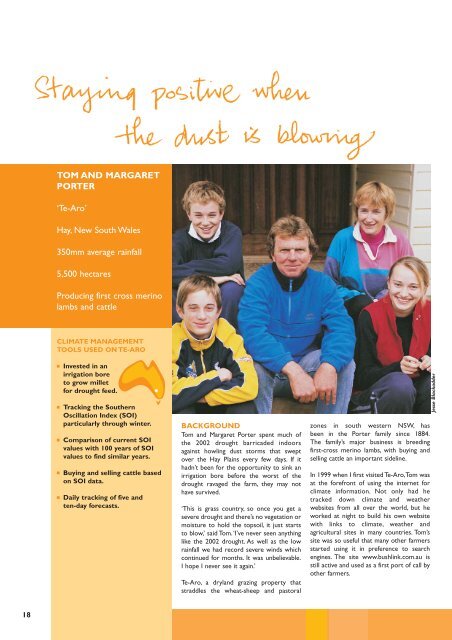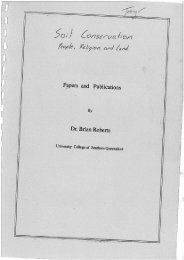Masters of the Climate: Innovative farmers ... - South West NRM
Masters of the Climate: Innovative farmers ... - South West NRM
Masters of the Climate: Innovative farmers ... - South West NRM
Create successful ePaper yourself
Turn your PDF publications into a flip-book with our unique Google optimized e-Paper software.
TOM AND MARGARET<br />
PORTER<br />
‘Te-Aro’<br />
Hay, New <strong>South</strong> Wales<br />
350mm average rainfall<br />
5,500 hectares<br />
Producing first cross merino<br />
lambs and cattle<br />
CLIMATE MANAGEMENT<br />
TOOLS USED ON TE-ARO<br />
<br />
<br />
<br />
<br />
<br />
Invested in an<br />
irrigation bore<br />
to grow millet<br />
for drought feed.<br />
Tracking <strong>the</strong> Sou<strong>the</strong>rn<br />
Oscillation Index (SOI)<br />
particularly through winter.<br />
Comparison <strong>of</strong> current SOI<br />
values with 100 years <strong>of</strong> SOI<br />
values to find similar years.<br />
Buying and selling cattle based<br />
on SOI data.<br />
Daily tracking <strong>of</strong> five and<br />
ten-day forecasts.<br />
BACKGROUND<br />
Tom and Margaret Porter spent much <strong>of</strong><br />
<strong>the</strong> 2002 drought barricaded indoors<br />
against howling dust storms that swept<br />
over <strong>the</strong> Hay Plains every few days. If it<br />
hadn’t been for <strong>the</strong> opportunity to sink an<br />
irrigation bore before <strong>the</strong> worst <strong>of</strong> <strong>the</strong><br />
drought ravaged <strong>the</strong> farm, <strong>the</strong>y may not<br />
have survived.<br />
‘This is grass country, so once you get a<br />
severe drought and <strong>the</strong>re’s no vegetation or<br />
moisture to hold <strong>the</strong> topsoil, it just starts<br />
to blow,’ said Tom.‘I’ve never seen anything<br />
like <strong>the</strong> 2002 drought. As well as <strong>the</strong> low<br />
rainfall we had record severe winds which<br />
continued for months. It was unbelievable.<br />
I hope I never see it again.’<br />
Te-Aro, a dryland grazing property that<br />
straddles <strong>the</strong> wheat-sheep and pastoral<br />
zones in south western NSW, has<br />
been in <strong>the</strong> Porter family since 1884.<br />
The family’s major business is breeding<br />
first-cross merino lambs, with buying and<br />
selling cattle an important sideline.<br />
In 1999 when I first visited Te-Aro,Tom was<br />
at <strong>the</strong> forefront <strong>of</strong> using <strong>the</strong> internet for<br />
climate information. Not only had he<br />
tracked down climate and wea<strong>the</strong>r<br />
websites from all over <strong>the</strong> world, but he<br />
worked at night to build his own website<br />
with links to climate, wea<strong>the</strong>r and<br />
agricultural sites in many countries. Tom’s<br />
site was so useful that many o<strong>the</strong>r <strong>farmers</strong><br />
started using it in preference to search<br />
engines. The site www.bushlink.com.au is<br />
still active and used as a first port <strong>of</strong> call by<br />
o<strong>the</strong>r <strong>farmers</strong>.<br />
Jesse Blackadder<br />
18
















